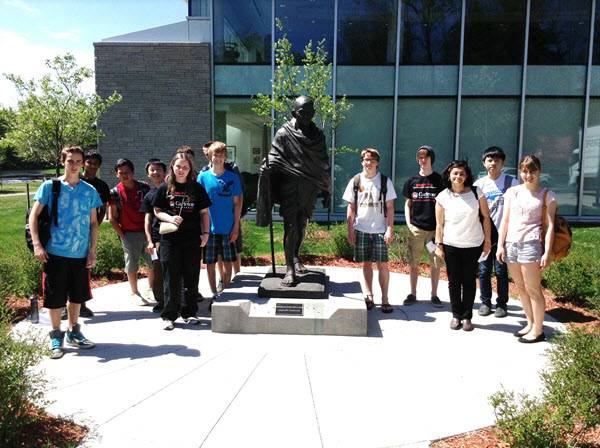EMCP 2013 — GANDHI COURSE REPORT
Dr. Mayurika Chakravorty
Course: How to Win a War without Weapons – Gandhi and his Ideas
I taught the course entitled “How to Win a War without Weapons: Gandhi and his Ideas” at Carleton University from May 6-10, 2013. It was offered as a part of the EMCP program (Enrichment Mini-Courses Program) offered to students from grades 8-10. The course was attended by 12 students mostly from grades 8 and 9 while one student was from grade 10. Their ages ranged from 13-15. The students came from schools under the Ottawa Carleton District School Board, Ottawa, Carleton Catholic School Board and the Upper Canada District School Boards.

Class participants with the teacher, Mayurika Chakravorty
at the Gandhi statue site at Carleton University
It was a wonderfully refreshing experience to teach a greatly motivated group of young kids. Although most of them had heard about Gandhi before, this was their first real encounter with his life and ideas. When asked to write about why they chose this course, they gave surprisingly thoughtful and mature answers. For example, one student wrote: “I chose to attend this course because I think that understanding Gandhi’s philosophy is very important not only for people interested in government and diplomacy but for anybody trying to deal peacefully with problems and conflicts in their everyday lives.” Another wrote: “I was very pleased to see that this course was available and that I could have more in-depth knowledge about peace-making, possibly world issues and of course more about Gandhi’s life.” Another student wrote: “I took this course because I’m in a peace organization called CISV and a lot of what Gandhi stood for is similar to what CISV does. So I thought it would be interesting to see if what I learn in this class is transferrable to CISV.” There were a couple of students who wrote that they “want to take this course because they want to go into government and diplomacy as a career and wanted to learn about resolving conflicts peacefully.”
Thus I had a rather daunting task of tailoring the course to meet these expectations. Having no prior experience of teaching this age-group before, I had been warned at preceding workshops about the attention span and the level of energy that these kids usually have. Within the first day or so, I understood that unlike college students, they learn more by doing than by listening to lectures. So I devised very interactive lesson plans and invited them to share their ideas individually or in groups. On the upside, unlike college students they were extremely forthcoming and generous in sharing their thoughts and opinions. Knowing that most of them did not have a clear picture of who Gandhi was, I screened Attenborough’s Gandhi feature film in an active learning mode. That is, we watched the movie in several sessions of 20 minutes or so, followed by questionnaires and group discussions in think-pair-share format. Although this took a very long time, it was a highly fruitful exercise because not only could the students familiarize themselves with the historical characters and contexts, they could also discuss the power and influence of Gandhian methods. For example, by the end of the movie, they knew besides Gandhi, the other key figures and events of Indian nationalism and the significant events in Gandhi’s life.
When asked about what they had learned from the movie, most of them wrote they didn’t know before that Gandhi was in South Africa, that he was a lawyer, that he was assassinated by a Hindu radical, that colonization could be so exploitative and brutal in use of force, that Bangladesh and Pakistan were part of India before. Some of them also wrote that they didn’t know Gandhi wore western clothes before and that they found out who the untouchables were. Quite a few of them said that he/she would have wanted the movie to include Gandhi’s childhood.
One day, I took the students to see the Gandhi statue in front of the River building and we had a wonderful writing session by the river across from the statue. In another session we engaged with a list of thematically organized quotes from Gandhi, for example on issues of non-violence, peaceful resistance, conflict resolution, social justice, dignity, poverty and environmental issues. This culminated in a highly successful poster presentation event by the students.
The students also wrote a brief essay on the relevance of Gandhi in their life or in today’s world. They also shared several interesting ideas on how to incorporate Gandhian thoughts and methods into school events and curricula.
Overall, it was a highly rewarding experience and I thoroughly enjoyed teaching this very special group of kids. It was also a learning experience for me as I could recalibrate and re-assess my own understanding of what Gandhi and his ideas mean or how are they relevant to today’s youth in a larger global context.